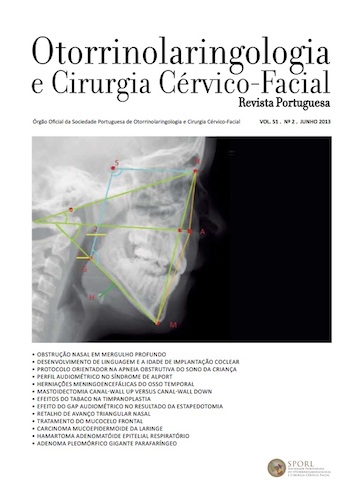Effect of pre-operative air-bone gap on technical success of stapes surgery
DOI:
https://doi.org/10.34631/sporl.22Keywords:
Otosclerosis, air-bone gap, stapedotomyAbstract
Introduction: The aim was to determine the influence of preoperative air-bone gap (ABG), as independent prognostic factor, on technical success of stapes surgery.
Methods: We reviewed charts of 118 case stapedotomies with an incomplete ABG closure (ABG>10dB), and 285 control stapedotomies with a complete ABG closure (ABG≤10dB). We retrospectively recorded preoperative air-conduction, bone-conduction, and ABG. We then classified both case and control groups into two categories according to the preoperative mean air-bone gap (ABG≤30dB and ABG>30dB). Multivariate logistic-regression model was used for casecontrol comparisons.
Results: Thirty-five case surgeries had a preoperative ABG≤30dB (percent [%], 29.6) against 83 case surgeries had a preoperative>30dB (%, 70.4). On the over hand, 118 control surgeries had a preoperative ABG≤30dB (%, 41.4) against 167 control surgeries had a preoperative ABG>30dB (%, 58.6). The mean preoperative ABG was 41.7dB in case group (standard deviation [SD], 7.7) and 32.4dB in control group (SD, 7.5). Preoperative ABG≤30dB was associated with better technical success (odds ratio, 1.68; 95% confidence interval [CI], 1.06 to 2.65). Association persists when age, race, side ear and diameter of prosthesis were included in the multivariate model (adjusted odds ratio, 1.70; 95% CI, 1.07 to 2.7).
Conclusions: Our findings suggest that ABG can be a valid prognostic factor to predict technical success of stapes surgery. The magnitude of ABG closure is superior in cases with minor preoperative ABG when compared with those with greater preoperative ABG.
Downloads
References
Karosi T, Sziklai I. Etiopathogenesis of otosclerosis. Eur Arch Otorhinolaryngol. 2010; 267:1337-1349.
Shea J. Forty years of stapes surgery. Am J Otol, 1998. 19(1):52-5.
Committee on Hearing and Equilibrium guidelines for the evaluation of results of treatment of conductive hearing loss. AmericanAcademy of Otolaryngology-Head and Neck Surgery foundation, Inc. Otolaryngol Head Neck Surg. 1995; 113:186-187.
Monsell EM. New and revised reporting guidelines from the Committee on Hearing and Equilibrium. American Academy of Otolaryngology-Head and Neck Surgery Foundation, Inc. Otolaryngol Head Neck Surg. 1995; 113:176-178.
Shea J, Farrior J. Stapedectomy and round window closure. Laryngoscope. 1987;97:10–2.
Amedee R, Lewis M. Obliterative otosclerosis. Laryngoscope. 1987;97:922–4.
Aarnisalo A, Vasama JP, Hopsu E, Ramsay H. Long-term hearing results after stapes surgery: a 20-year follow-up. Otol Neurotol. 2003. 24(4):567-71.
Somers T, Govaerts P, Marquet T, Offeciers E. Statistical analysis of otosclerosis surgery performed by Jean Marquet. Ann Otol Rhinol Laryngol. 1994. 103(12): 945-51.
Ramsay H, Karkkainen J, and Palva T. Success in surgery for otosclerosis: hearing improvement and other indicators. Am J Otolaryngol. 1997. 18(1): 23-8.
Gros A, Vatovec J, Zargi M, Jenko K. Success rate in revision stapes surgery for otosclerosis. Otol Neurotol. 2005. 26(6):1143-8.
Bruijn AJ, Tange RA, and Dreschler WA. Efficacy of evaluation of audiometric results after stapes surgery in otosclerosis. I. The effects of using different audiologic parameters and criteria on success rates. Otolaryngol Head Neck Surg. 2001. 124(1):76-83.
Kisilevsky VE, Bailie NA, Halik JJ. Results of stapedotomy in otosclerosis with severe and profound hearing loss. J Otolaryngol Head Neck Surg. 2010; 39:244-252.






